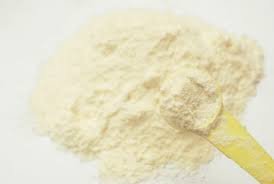Powdered milk is something that most of us have a tendency to turn up our nose at, but in our food storage, it is an extremely versatile food that provides protein, calcium and nutrition. It also provides 80 calories per serving. Most vitamins in dried milks are present in comparable levels to those of whole milk (this does decrease with age). Vitamins A and D are not present in non-fat milk and must be supplemented.
Additionally it gives us the ability to cook a much wider variety of foods. For instance, you can make prepper cheese and cottage cheese, as well as use it in baking, soups and hundreds of other dishes.
Based on studies conducted by Brigham Young University, the LDS Church (Mormon) says that it can have a shelf life of 20 years.
Other studies conducted by Utah State University showed the following:
Non-fat dried milk (NFDM) is suitable for short and long term emergency food storage. It is made from non-fat, grade A milk that has been dried by spraying into hot air or heated on a drum. The process removes nearly all of the water prohibiting the growth of microorganisms. Dried whole milk and dried buttermilk have milk fat and are not suitable for long term storage.
They went on to state:
Dried milk must be stored free of moisture and oxygen. Mylar-type bags and #10 cans make good containers for large quantities. Canning jars are suitable for smaller quantities provided light is prevented from reaching the dried milk. Other plastic containers are less suitable, e.g. food-grade buckets. Oxygen absorbers should be used to remove oxygen from containers to extend shelf life and minimize off-flavors.
A USU study concluded that after 4-year NFDM samples stored in plastic bags (not Mylar-type) were statistically less acceptable than samples stored in cans. The form of milk (instant or regular) did not affect the length of time NFDM could be stored. Unacceptability of samples in the study was due to an oxidized/stale flavor.
Now, one thing to be aware of is to make sure you are purchasing real powdered milk. Many companies are selling so-called milk alternatives. One example is made from sweet dairy whey, non-fat dry milk solids, partially hydrogenated vegetable oil (contains one or more of the following:canola oil and/or soya oil), corn syrup solids, sodium caseinate, dipotassium phosphate, propylene glycol monostearate, mono and diglycerides, lecithin, carrageenan, Vitamin A, Vitamin D.
Personally, I prefer to stay with the real milk, and avoid the various additives. Be sure and store at least 25-50 lbs of powdered milk per person and rotate it by using the oldest packages in your cooking, baking, and milk-drinking.
Howard


[lasso rel="emergency-preparedness-more-a-manual-on-food-storage-and-survival-2nd-edition-revised-and-updated" id="35334"]